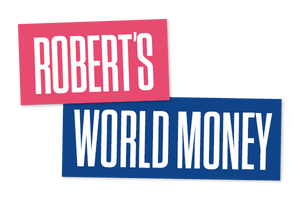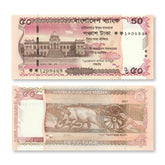Banknote Catalogs
For experienced collectors this may be old hat. But if you've ever wondered about jumbles of letters and numbers in banknote listings—B227f, P59f, R241b, P-New, PNL, PNL, PNL—you've come to the right place. (Hint: the first three are all the same note.)
A comprehensive, accurate banknote catalog is a collector’s best friend. Whether it’s country-specific or global in scope, a good catalog will describe each note, the relative scarcity and resulting price. Especially if you dip your toes into buying on eBay, there’s no way to tell if that beautiful $1,500 note is a bargain or a ripoff. (The subject of a future post. In short, buyer beware. Catalogs can help.)
A good banknote catalog is a:
-
Menu It gives you a listing of banknotes that are out there.
-
Field Guide See a note out in the wild? A catalog will help you identify the country, type and variety. So next time you strap on your waders, grab your binoculars and visit another country or a coin show, bring your catalog(s) along!
-
Price Guide A banknote catalog typically provides values for banknotes in different conditions. Depending upon the catalog’s age, frequency of publication or method of calculating them, the pricing is more a general guide than an accurate valuation.
-
Fraud Protection Scarcity is a dominant factor in a banknote’s value. The highest denomination in a series isn’t always the most valuable one. Or some type varieties can be worth 10 times the others. That ”rare opportunity” on eBay may be an actual rare opportunity, or it could be offered at 100 times the actual value. A banknote catalog can’t prevent all fraud, but it can prevent unforced errors in many cases.
-
Encyclopedia Like an encyclopedia when you were a kid, scouring through a catalog provides detail about the country, issuing authorities, security features, and help identify people, locations, and other subjects featured on banknotes.
Global Catalogs
The Original Heavyweight: The Standard Catalog of World Paper Money
For decades, the gold standard was the Standard Catalog of World Paper Money (SCWPM), published by Krause Publications. Originally curated by Albert Pick, his eponymous Pick numbers remain the most widespread numbering system for notes all over the world. It is a giant three-volume set available in print. These would sit proudly in my bookcase like old Encyclopedia Britannicas.
The three volumes are:
Standard Catalog of World Paper Money - General Issues, 1368–1960
This was last published in 2016 (16th edition).
Standard Catalog of World Paper Money - Modern Issues, 1961–Present
The last edition—its 25th—was published in 2019.
Standard Catalog of World Paper Money - Specialized Issues
The 12th edition was published in 2013.
The Standard Catalog of World Paper Money is the undisputed champ of the encyclopedic global banknote catalogs. Well, it was anyway.
The New Champ: The Banknote Book
In 2011, out of frustration with inaccuracies with the SCWPM, collector Owen Linzmayer began cataloging notes country-by-country himself (along with dozens of collaborators) into The Banknote Book, initially releasing 10 country-specific chapters. In 2021 it was acquired by CDN Publishing. Now, as of May 2024, The Banknote Book now has over 320 individual country chapters covering nearly 100,000 banknote types and varieties.
The Standard Catalog of World Paper Money was updated like old school software upgrades—one giant update every few years. The Banknote Book is more like new school cloud software, with updates on a rolling basis. The Banknote Book publishes chapters individually, and typically several are updated weekly as more accurate info or better quality scans come in.
The Banknote Book’s David has become a bit of a Goliath itself. In a zero-sum world, these two would battle in an epic Alien vs. Predator fight. Fortunately they can peacefully coexist as the basics of a collector’s bibliography.
The Standard Catalog of World Paper Money lost most of its remaining luster in 2019 when its publisher Krause sold the database and publishing rights to two different entities, and updates are very much in limbo right now.
I prefer The Banknote Book in nearly every way, however, and unless your collecting focus is on one of the rapidly shrinking list of countries not yet published, it’s what I recommend starting with. It's more accurate, has full-color images, greater detail in descriptions and security features, includes the size of banknotes—it's really no comparison.
The only thing is Pick numbers remain the most common reference and many times are the only one listed. For any banknote beyond roughly 2018 or 2019, Pick numbers don't really exist anymore, and The Banknote Book is the only reference beyond this time period.
On this website—which leans toward newer issues within most collectors' budgets—The Banknote Book is the primary reference, though if a Pick number exists for a banknote it's cross-referenced. I'm tired of including P-New or PNL (not listed) for an increasingly large number of banknotes, so if you don't see a Pick number, the banknote doesn't have one.
Oh, and I'm a purist. Many people continued assigning Pick numbers for banknotes issued after the last Standard Catalog of World Paper Money was published, and there seems to be a few different people doing so. It's a practice rife with confusion and misidentification. So for newer varieties I'll identify the type (P64), but not a variety (P64g). And I won't use Pick numbers if it's not in the 25th and last edition of the SCWPM sitting within arm's reach. The Banknote Book has it covered anyway.
Country or Regional Catalogs
While The Banknote Book and Standard Catalog of World Paper Money both cover the entire globe in scope, many other catalogs focus on a single country or region.
Two examples are the Renniks Australian Coin & Banknote Values catalog, which published its 32nd edition in late 2023, and the Professional Catalog of Lebanese Banknotes. Countless others catalogs are out there as well. I hope to assemble a list some day soon.
Catalog Numbering Systems
If you've read this far and are still waiting for me to explain the alphabet soup in most banknote listings, we're finally here!
Most banknote catalogs follow a similar style of distinguishing their notes, assigning a catalog number that identifies the catalog itself, the banknote type, and its variety. So as explained above, a "P" catalog number is a Pick number, named after the original editor of the SCWPM. The Banknote Book uses a "B" prefix to identify it. Renniks Australian Coin & Banknote Values catalog uses an "R", and the Professional Catalog of Lebanese Banknotes uses "PCLB" for its prefix.
Typically the number that follows is the type, followed by a letter to distinguish its variety. More explanation on types and varieties will come. But for now, I added a graphic below that should prove helpful deciphering catalog numbers.
Oh, I almost forgot—for Banknote Book and Pick numbers, the catalog number cannot identify a banknote alone. The first banknote a country issues will always be a P1 or B101a. So these numbers need to be paired with a country or issuer name to fully identify it.
This becomes less necessary with specialized country catalogs. For example, the new Lebanese 100,000 Livres issued in November 2023 has a catalog number PCLB138a. The PCLB nomenclature is unique to this catalog that only covers Lebanon, so there would be less opportunity for confusion here.
So there you have it. The graphic below demonstrates this basic catalog+type+variety nomenclature, review that and we're all good! Sort of. Nuance requires a country+catalog+prefix+type+suffix+

Nuances. Always Nuances.
OK, Johnathan, that seemed fairly easy, and checking out your graphic really helped. I got this! Not so fast. This is how many—but not all—banknote catalogs apply their reference numbering.
David Mills (of the excellent frenchbanknotes.com, a comprehensive site focusing on French and French-inspired banknotes) pointed out that the catalog Les Billets du Maghreb et du Levant (Banknotes of the Maghreb and the Levant), is one example that does not follow this scheme. The catalog, which covers the 10 or so countries in the North Africa area, starts with Algeria at MK #1, and continues without interruption through the countries, so Tunisia starts at #401. Confusing.
Accounting for Monetary Unions and Other Trickery
And even within the SCWPM and Banknote Book there are some nuances, like with monetary unions, which may add a suffix letter. West African States, Central African States, and East Caribbean States are examples where individual country codes have been assigned to issuers within the monetary union, and the catalogs append that code as a suffix to the type number. I'll clarify this on this page when I have more time.
When an Uncatalogued Note Needs to Find its Logical Order
Sometimes a new note is discovered, or a later variety changes sufficiently to be promoted to a type, or for other reasons a banknote needs to be inserted logically into numerical order, but without numbers to do so. When the SWCPM needed to insert a new type between, say P45 and P46, they typically appended an A, to create P45A. The Banknote Book will add a half number, inserting B349.5 in-between B349 and B350. (I'll also clarify this given the time.)
OK, well, that's all for the moment. Appreciation to David Mills for his insight and inputs to improve this discussion. Your feedback is also welcome!
- Choosing a selection results in a full page refresh.




























